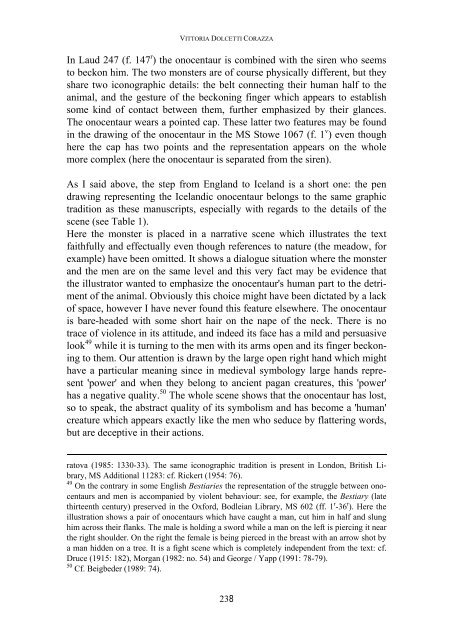Crossing paths in the Middle Ages: the Physiologus in Iceland - Lear
Crossing paths in the Middle Ages: the Physiologus in Iceland - Lear
Crossing paths in the Middle Ages: the Physiologus in Iceland - Lear
Create successful ePaper yourself
Turn your PDF publications into a flip-book with our unique Google optimized e-Paper software.
VITTORIA DOLCETTI CORAZZA<br />
In Laud 247 (f. 147 r ) <strong>the</strong> onocentaur is comb<strong>in</strong>ed with <strong>the</strong> siren who seems<br />
to beckon him. The two monsters are of course physically different, but <strong>the</strong>y<br />
share two iconographic details: <strong>the</strong> belt connect<strong>in</strong>g <strong>the</strong>ir human half to <strong>the</strong><br />
animal, and <strong>the</strong> gesture of <strong>the</strong> beckon<strong>in</strong>g f<strong>in</strong>ger which appears to establish<br />
some k<strong>in</strong>d of contact between <strong>the</strong>m, fur<strong>the</strong>r emphasized by <strong>the</strong>ir glances.<br />
The onocentaur wears a po<strong>in</strong>ted cap. These latter two features may be found<br />
<strong>in</strong> <strong>the</strong> draw<strong>in</strong>g of <strong>the</strong> onocentaur <strong>in</strong> <strong>the</strong> MS Stowe 1067 (f. 1 v ) even though<br />
here <strong>the</strong> cap has two po<strong>in</strong>ts and <strong>the</strong> representation appears on <strong>the</strong> whole<br />
more complex (here <strong>the</strong> onocentaur is separated from <strong>the</strong> siren).<br />
As I said above, <strong>the</strong> step from England to <strong>Iceland</strong> is a short one: <strong>the</strong> pen<br />
draw<strong>in</strong>g represent<strong>in</strong>g <strong>the</strong> <strong>Iceland</strong>ic onocentaur belongs to <strong>the</strong> same graphic<br />
tradition as <strong>the</strong>se manuscripts, especially with regards to <strong>the</strong> details of <strong>the</strong><br />
scene (see Table 1).<br />
Here <strong>the</strong> monster is placed <strong>in</strong> a narrative scene which illustrates <strong>the</strong> text<br />
faithfully and effectually even though references to nature (<strong>the</strong> meadow, for<br />
example) have been omitted. It shows a dialogue situation where <strong>the</strong> monster<br />
and <strong>the</strong> men are on <strong>the</strong> same level and this very fact may be evidence that<br />
<strong>the</strong> illustrator wanted to emphasize <strong>the</strong> onocentaur's human part to <strong>the</strong> detriment<br />
of <strong>the</strong> animal. Obviously this choice might have been dictated by a lack<br />
of space, however I have never found this feature elsewhere. The onocentaur<br />
is bare-headed with some short hair on <strong>the</strong> nape of <strong>the</strong> neck. There is no<br />
trace of violence <strong>in</strong> its attitude, and <strong>in</strong>deed its face has a mild and persuasive<br />
look 49 while it is turn<strong>in</strong>g to <strong>the</strong> men with its arms open and its f<strong>in</strong>ger beckon<strong>in</strong>g<br />
to <strong>the</strong>m. Our attention is drawn by <strong>the</strong> large open right hand which might<br />
have a particular mean<strong>in</strong>g s<strong>in</strong>ce <strong>in</strong> medieval symbology large hands represent<br />
'power' and when <strong>the</strong>y belong to ancient pagan creatures, this 'power'<br />
has a negative quality. 50 The whole scene shows that <strong>the</strong> onocentaur has lost,<br />
so to speak, <strong>the</strong> abstract quality of its symbolism and has become a 'human'<br />
creature which appears exactly like <strong>the</strong> men who seduce by flatter<strong>in</strong>g words,<br />
but are deceptive <strong>in</strong> <strong>the</strong>ir actions.<br />
ratova (1985: 1330-33). The same iconographic tradition is present <strong>in</strong> London, British Library,<br />
MS Additional 11283: cf. Rickert (1954: 76).<br />
49 On <strong>the</strong> contrary <strong>in</strong> some English Bestiaries <strong>the</strong> representation of <strong>the</strong> struggle between onocentaurs<br />
and men is accompanied by violent behaviour: see, for example, <strong>the</strong> Bestiary (late<br />
thirteenth century) preserved <strong>in</strong> <strong>the</strong> Oxford, Bodleian Library, MS 602 (ff. 1 r -36 r ). Here <strong>the</strong><br />
illustration shows a pair of onocentaurs which have caught a man, cut him <strong>in</strong> half and slung<br />
him across <strong>the</strong>ir flanks. The male is hold<strong>in</strong>g a sword while a man on <strong>the</strong> left is pierc<strong>in</strong>g it near<br />
<strong>the</strong> right shoulder. On <strong>the</strong> right <strong>the</strong> female is be<strong>in</strong>g pierced <strong>in</strong> <strong>the</strong> breast with an arrow shot by<br />
a man hidden on a tree. It is a fight scene which is completely <strong>in</strong>dependent from <strong>the</strong> text: cf.<br />
Druce (1915: 182), Morgan (1982: no. 54) and George / Yapp (1991: 78-79).<br />
50 Cf. Beigbeder (1989: 74).<br />
238

















